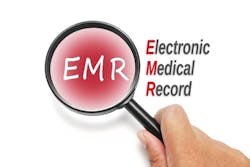Clinicians to Researchers: ‘EMRs Are Not a Place to Go Fishing’
The ubiquity of electronic health records has allowed health researchers to expand the scope of their studies into the clinical efficacy of different treatments. But clinical informaticists responsible for creating front-line EHR tools are not always enthusiastic in their response to data requests from researchers if they are not specific enough.
Daniel Lemkin, M.D., director of medical informatics, emergency medicine, at University of Maryland Medical Center, said, “You have to be cognizant of what you are asking for, because there are lots of data points in these EMRs. Unless you specify exactly what you are looking for and how it answers your research question, you are going to get noise. EMRs are not a place to go fishing unless you have a lot of money and time to waste.”
Lemkin was speaking last week during a Grand Rounds of the Johns Hopkins University Division of Health Sciences Informatics. He set out to explain to researchers the perspective of people on the front lines of care. “I have experience building front-end tools the clinicians are going to use to enter data into a system and then mining that data out for very specific research requests,” he said. The researchers then put the data into data warehouses to be used for multiple purposes, including research studies.
“As researchers, you have a very legitimate question and you want data out of our system,” he said. “When you come and make that request, we are not thinking about looking to make any additional effort in order to capture the discreet data you are interested in. And this is not a malicious or cynical response; it is just a realistic response. Noting that there are many studies about clinician burnout associated with EMR use, Lemkin said researchers have to understand how much pressure clinical people are under on a daily basis while using these systems.
He asks researchers to go back and consider what the EHR is for. It is to document diagnoses, the nursing flow sheet data, clinical notes, serving as a historical record to later see what happened. “It also is there for financial purposes — we have to bill if we want to keep these hospitals open,” he said. “A lot of the changes entered into these systems are at the behest of the insurance companies that demand it, especially CMS. And it serves as a legal data source, to both protect us and to sink us.”
So why are clinicians not leaping for joy when they are presented with additional requests for data elements to be added to their work flows? “It’s not because we don’t want to help,” Lemkin said. “It’s because everyone has a pet project.” People from anesthesiology want us to add a flag to the header that says the patient has a difficult airway; and the transplant people want you to put a flag in the header saying this person has a transplant. “There are requests coming out of the woodwork, and there is only so much we can ask people to do,” he added, “and there are already people asking us to do things that we can’t say no to.”
But there is a silver lining, Lemkin said. “There is a ton of data in the EMR you can use; you just have to know how to get access to it. And it’s not just that the data is there and you can mine it; it is also that you can leverage the data that is there as well as the numerous hooks on the back end to facilitate research initiatives. If you are doing clinical trials, and you want notification when a patient hits the door in a certain clinic, or an ED, that stuff can be built out and you can trigger these notifications based on a list of criteria and customize messages.”
He added that although there is lots of amazing work being done to reconcile all the specific data systems and modeling that data into something that is consumable, shareable and usable, that effort is only as good as its weakest link. “People doing the mapping and modeling, if they don’t understand what they are mapping and modeling, then the quality and validity of that data is going to be questionable.”
He gave an example of a research pet peeve: Researchers come to his team and say they want all data associated with patients who come in to the ED complaining of chest pain. “This is nonsense. I say come back to us when you are serious,” Lemkin said. The overly broad request shows they haven’t put a lot of time and effort into the question and they don’t know what they are looking for, he explained.
“The data is there,” Lemkin stressed. “If you know where you are supposed to look and have a very specific question, you can get incredibly accurate data.”


